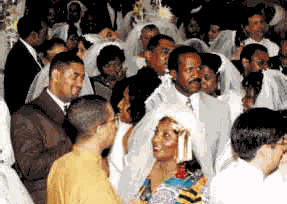
40 Years in America

|
|
40 Years in America |
|
The Globalization of the Blessing

During the mid-í90s the Blessings expanded to local ceremonies at Christian Churches all across America.
The sanctification of families through International Marriage Blessings was the third prong in the movementís program for world peace and unification. Sanctification within the Christian tradition referred primarily to the transformation or perfection of individuals. However, Unificationists understood that a whole new historical epoch had begun in which there had occurred a fundamental shift in the order of salvation from the individual to the family. Therefore, the movementís understanding of sanctification related mainly to the family and family formation. The gateway to the sanctification process was the Blessing that became a major point of emphasis for the movement during the middle and late 1990s.
Sanctification was an important complement to movement-sponsored dialogues and reconciliation efforts. The first two prongs in its program for world peace and unification essentially dealt with conflict-resolution. The third prong, the sanctification of families through the Blessing, was understood to eliminate the root cause of human conflict and division. In essence, it was a process through which men and women came into union with one another, engrafted into the True Parents, reconciled with God, and thereby reconstituted themselves as a new humanity. In this process, there were important internal and external components. Internally, the Blessing was understood to cleanse couples and their future progeny from the taint of original sin.
Externally, blessed couples were to exemplify world peace and unification. The movement encouraged international, intercultural and interracial matches in large International Marriage ceremonies dedicated to "World Peace Through Ideal Families."
Prior to the beginning of the Completed Testament Age, the Blessing was a narrow gate. It was restricted almost exclusively to Unification Church members. However, the situation changed dramatically after 1993. The essential difference was that the Blessing became open, and Rev. Moon stated his intention of blessing hundreds of thousands and even hundreds of millions of couples before the year 2000. This shift and the accompanying goals were the result of altered circumstances. The collapse of communism in Eastern Europe and the Soviet Union as well as the movementís access to communist leaders and breakthroughs in both communist and post-communist worlds were all crucial.
However, Rev. and Mrs. Moonís public declarations of True Parents, messiahship, and the Completed Testament Age were equally important. As a consequence, Rev. Moon had every expectation that a new messianic age was about to dawn. The most visible sign of this was what members came to call the globalization of the Blessing.
The globalization process affected movement practices and eventually membersí thinking about the Blessing. Prior to the CTA, members endured lengthy preparation periods that extended from the time they joined the movement until they were blessed. During this time, they were strictly celibate and fulfilled regular membership duties as well as special conditions associated with the Blessing, such as bringing three new converts and completing a seven-day fast. All were "matched" by Rev. Moon and required official permission to "start their families." A major departure after 1993 was that these conditions did not apply to the overwhelming majority of those being blessed. The reason for this was simple. They were not Unification Church members. For most of these couples, there was no formal preparation at all. In most cases, the Blessing came as suddenly as a knock on the door. In fact, as the numerical totals climbed into the millions, the majority had only the most limited and rudimentary understanding of the Blessing if, indeed, they understood that they were blessed at all.
There also were departures from basic ritual practices. For most Unificationists, the Holy Wine Ceremony was the centerpiece of the Blessing. It signified the cleansing of original sin, or in Unification terms, the "change of blood lineage." As far as possible, members preserved the integrity of this ceremony. They offered holy wine in living rooms, on beaches, at county fairs and elsewhere according to accepted formulae. However, there also were adaptations and eventually innovations that bore only a faint resemblance to the original tradition. Some couples refused wine. In these cases, members distributed grape juice referred to as "holy nectar." Others had compunctions about accepting drinks from strangers. In these instances, it was sometimes maintained that sniffing the wine or dipping oneís finger into a cup was sufficient. Once again, as numbers accelerated into the millions, enterprising members distributed holy "lemonade" to thirsty beachgoers or downtown pedestrians, usually with little or no explanation of its benefits. Others distributed holy candy with printed blessing affirmations.
Globalization, in effect, resulted in the spiritualization and democratization of the Blessing. Whereas eligibility had been interpreted previously in literal and legal terms, the movement now incorporated symbolic content and a more accentuated theology of grace. There was significantly more emphasis placed on benefits available through "the merit of the age." The grace of the Blessing was understood to accrue to people regardless of their effort or even their awareness. Rev. Moon stated that those born after the True Parentsí Holy Matrimony in 1960 were already blessed. He later extended the period to include those born after he began his public ministry in 1945. Given this under- standing, excessive preoccupation with ritual or legalistic niceties was clearly misplaced. At the same time, continental leaders, tribal messiahs and eventually ordinary members were empowered to bless couples. This led to further experimentation and innovation.
Download entire page and pages related to it in ZIP format
Table of Contents
Information
Tparents Home